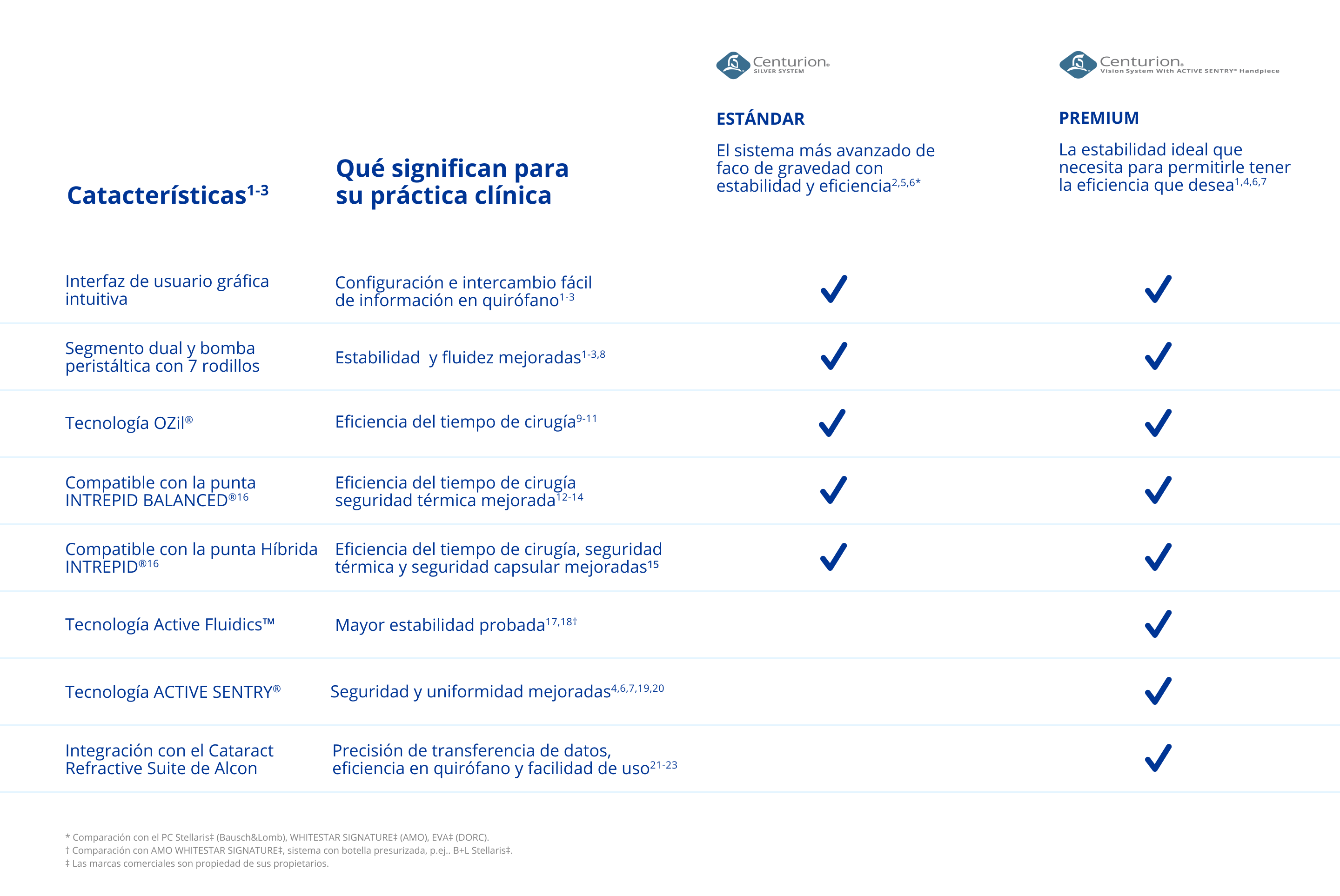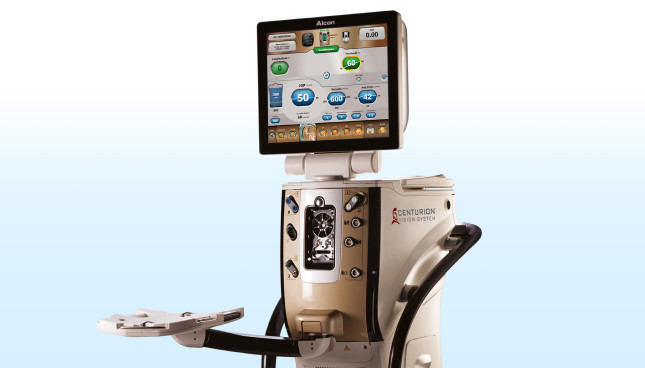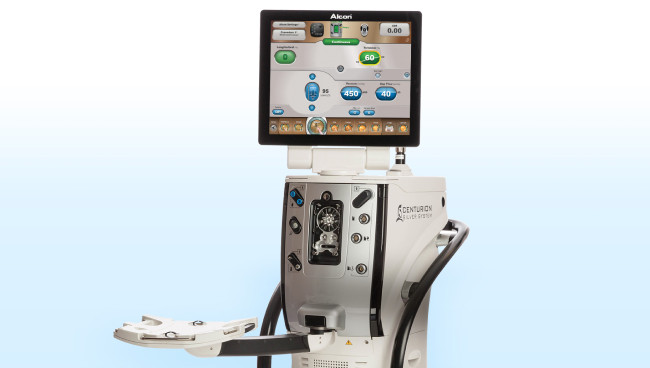Mejore su práctica clínica con el rendimiento avanzado de CENTURION®
Los sistemas de faco de Alcon, CENTURION®, le proporcionan a usted y a su clínica la tecnología líder en facoemulsificación. Obténga más información sobre cómo pueden ayudarle nuestros equipos CENTURION® en su clínica.
Mejore su práctica clínica con el rendimiento avanzado de CENTURION®
Los sistemas de faco de Alcon, CENTURION®, le proporcionan a usted y a su clínica la tecnología líder en facoemulsificación. Obténga más información sobre cómo pueden ayudarle nuestros equipos CENTURION® en su clínica.

CENTURION® Vision System con pieza de mano ACTIVE SENTRY®
La tecnología líder en facoemulsificación que ofrece una nueva referencia de seguridad, uniformidad y eficiencia en cada cirugía de cataratas.1,4,6,7,12,24-26

CENTURION® Silver System
El sistema de gravedad más avanzado, con estabilidad mejorada y eficiencia durante la facoemulsificación.5-7,17,27-30

Alcon Experience Academy
Para contenido de formación relevante creado por los líderes del sector
Referencias:
1. CENTURION® Vision System Operator’s Manual.
2. CENTURION® Silver System Operator’s Manual.
3. LEGION® System Operator’s Manual.
4. Alcon Data on File: Final engineering study report- Alcon phacoemulsification systems' occlusion break surge performance in support of comparison apps. May 3, 2017.
5. Sharif-Kashani et al. Comparison of occlusion break responses and vacuum rise times of phacoemulsification systems. BMC Ophthalmology 2014;14:96.
6. Aravena et al. Aqueous volume loss associated with occlusion break surge in phacoemulsifiers from 4 different manufacturers. J Cataract Refract Surg. 2018 Jul;44(7):884-888.
7. Thorne A, Dyk DW, Fanney D, Miller KM. Phacoemulsifier occlusion break surge volume reduction. J Cataract Refract Surg. 2018;44(12):1491-1496.
8. Hiroyuki Matsushima, Presentation in the 119th annual meeting of the Japanese Ophthalmological Society, 17 Apr 2015.
9. Christakis PG, Braga-Mele RM (2012) Intraoperative performance and postoperative outcome comparison of longitudinal, torsional, and transversal phacoemulsification machines. J Cataract Refract Surg. 38 (2): 234-241.
10. Leon et al. An evaluation of intraoperative and postoperative outcomes of torsional mode versus longitudinal ultrasound mode phacoemulsification: a Meta-analysis. Int Journal of Ophthalmology. 2016;9(6):890-7.
11. Zacharías J. Comparative thermal characterization of phacoemulsification probes operated in elliptical, torsional and longitudinal ultrasound modalities. ASCRS-ASOA Symposium and Congress; April 25-29, 2014; Boston, MA.
12. Khokhar et al. Effect of balanced phacoemulsification tip on the outcomes of torsional phacoemulsification using an active-fluidics system. J Cataract Refract Surg. 2017;43(1):22-28.
13. Zacharías J. Thermal characterization of phacoemulsification probes operated in axial and torsional modes. J Cataract Refract Surg. 2015;41(1):208-216.
14. Noguchi et al, Difference in torsional phacoemulsification oscillation between a balanced tip and a mini tip using an ultra-high-speed video camera. J Cataract Refract Surg. 2016; 42:1511–1517.
15. Shumway C. Utility of a novel hybrid phacoemulsification tip to prevent posterior capsule rupture. Presentation at ASCRS 2019, 3 7 May, San Diego.
16. Centurion® FMS Pack Directions for Use.
17. Nicoli CM, Dimalanta R, Miller KM. Experimental anterior chamber maintenance in active versus passive phacoemulsification fluidics systems. J Cataract Refract Surg. 2016;42(1):157:162.
18. Boukhny M , Sorensen G, Gordon R. A novel phacoemulsification system utilizing feedback based IOP target control. ASCRS-ASOA Symposium and Congress; April 25 29, 2014; Boston, MA.
19. Lehmann R. Automated Patient Eye Level by Sensor based handpiece. Presentation at ASCRS 2019, 3 7 May, San Diego.
20. Crandall AS. Role of Incision Leakage in Anterior Chamber Stability in Different Phacoemulsifier Systems. Presentation at ASCRS 2019, 3 7 May, San Diego.
21. VERION™ User Guide 2.6 / 3.1.
22. NGENUITY® User Guide 1.4.
23. Brooks et al. Consolidation of Imaging Modalities Utilizing Digitally Assisted Visualization Systems: The Development of a Surgical Information Handling Cockpit. Clinical Ophthalmology. 2020:14 557 569.
24. Malik PK, Dewan T, Patidar AK, Sain E. Effect of IOP based infusion system with and without balanced phacotip on cumulative dissipated energy and estimated fluid usage in comparison to gravity fed infusion in torsional phacoemulsification. Eye Vis (Lond). 2017;4:22.
25. Zacharias J. Laboratory assessment of thermal characteristics of three phacoemulsification tip designs operated using torsional ultrasound. Clin Ophthalmol. 2016:10;1095–1101.
26. Vasavada AR, et al. Comparison of torsional and microburst longitudinal phacoemulsification: A prospective, randomized, masked clinical trial. Ophthalmic Surg Lasers Imaging. 2010;41(1):109-114.
27. Dyk DW, Miller KM. Mechanical model of human eye compliance for volumetric occlusion break surge measurements. J Cataract Refract Surg.2018 Feb;44(2):231-236.
28. Alcon Data on File: Phacoemulsification Systems' Occlusion Break Surge Performance Report - Surge Tool App. May 20, 2020.
29. Narendran N, et al. The Cataract National Dataset electronic multicentre audit of 55 567 operations: Risk stratification for posterior capsule rupture and vitreous loss. Eye. 2009;23:31–37.
30. Salowi MA, et al. The Malaysian Cataract Surgery Registry: Risk indicators for posterior capsular rupture. Br J Ophthalmol. 2017;101:1466–1470.
31. Alcon Data on File 2019.
32. Intrepid® Transformer I/A Handpiece Directions for use.
Los productos Alcon cumplen con la normativa aplicable a productos sanitarios vigente. Consultar las instrucciones de uso de los productos para la lista completa de indicaciones, contraindicaciones y advertencias.


